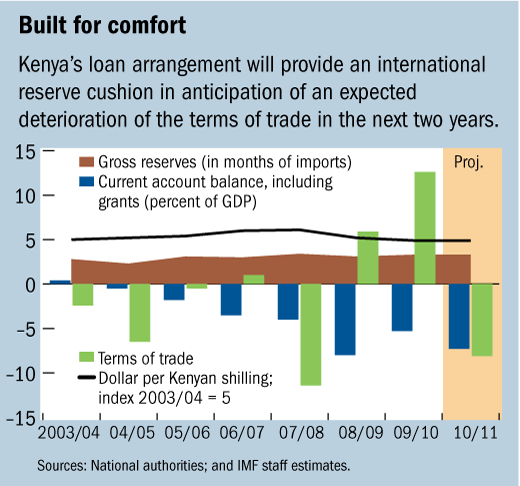
Typical street scene in Santa Ana, El Salvador. (Photo: iStock)
IMF Survey: IMF Lends $508.7 Million to Help Kenya Launch Key Reforms
February 8, 2011
- Kenya's program seeks key reforms in public finance management, tax policy
- Backs enactment of new constitution aiming at political transformation
- Fiscal adjustment allows priority investment for climate-change issues
The IMF approved a $508.7 million loan to back Kenya’s economic program, as the country embarks on reforms arising from the implementation of its new constitution.

Downtown Nairobi, Kenya: improved political climate in Kenya has spurred confidence; private investment is expected to accelerate (IMF photo)
EAST AFRICA
The program will help Kenya deal with vulnerabilities that could derail its efforts to accelerate growth, by strengthening the external position and reversing the rise in the debt burden resulting from recent fiscal stimulus.
Kenya’s loan was approved January 31 by the IMF’s Executive Board under the institution’s Extended Credit Facility, and is the largest such loan approved since the IMF’s new financing architecture for low-income countries became effective in mid-2009. The policies supported by the loan strike a balance between fiscal adjustment and making resources available for reforms envisaged in Kenya’s new constitution.
The new constitution, ratified in August 2010, provides for reforms on fiscal decentralization, the public expenditure framework, and land ownership. The constitution also addresses long-standing governance issues by strengthening the judiciary and laying the ground for an overhaul of the public finance management system that would effectively reduce the scope for corruption.
Higher private investment
The improved political environment in Kenya has spurred confidence, and private investment is expected to accelerate and support annual growth rates close to 7 percent over the medium term. Higher private investment will reinforce the ongoing economic recovery, initially driven by fiscal stimulus and benign weather conditions.
Kenya’s economic program will help sustain higher growth rates, with both private and public investment contributing to raise the investment-to-GDP ratio to 25 percent from 20 percent in 2009/10. Public investment will concentrate on
• Shifting sources of energy into geothermal power generation to help Kenya address climate-change issues.
• Participating in East African Community regional projects.
• Selectively eliminating infrastructure bottlenecks.
The loan arrangement will provide an international reserve cushion in anticipation of an expected deterioration of the terms of trade in the next two years (see chart). It will bring the debt-to-GDP ratio below the 45 percent ceiling over a three-year horizon, from the 47 percent of GDP projected for the next fiscal year.

The new framework for expenditure management and control will allow the government to rein in current spending while providing scope for allocating resources for implementing the constitution over the next two years; continuing with public investment plans; and protecting the vulnerable.
Rapid progress on financial inclusion will favor spreading the benefits of growth to a large share of Kenya’s population. Between 2006 and 2009, the mobile banking revolution has allowed an additional 14 percent of previously unbanked population to gain access to banking services.
Two-fifths of Kenya’s population now have access to formal financial services, which makes the country a leader in financial deepening in the sub-Saharan African region. Monetary and financial policies under the program will account for the impact of further progress in financial inclusion on financial deepening and monetization—the promotion of efficient payment, savings, and credit instruments. Policies will also address emerging risks associated with a changing financial landscape.
Gradual fiscal consolidation
Kenya’s program will focus initially on the central government, but will expand to encompass the general government before fiscal decentralization takes place. Main fiscal measures under the program include
• Introduction of a modern value-added tax law and appointment of a tax reform commission that will oversee the simplification of the tax code to improve administration and compliance.
• New public finance management legislation that will reinforce expenditure control, and will provide the legal support for establishing a fully functioning single treasury account system.
• Increased use of concessional foreign financing that will help reduce the government’s reliance on domestic financing.
The Central Bank of Kenya will focus on its medium-term inflation target of 5 percent, taking into consideration the impact of rapid progress on financial inclusion on monetization and financial deepening.
Under the program, the central bank will also purchase foreign exchange as needed to achieve the foreign reserve target while maintaining the floating exchange rate regime; enhance coordination of monetary and fiscal policy to minimize liquidity volatility; and tighten monetary policy promptly if the inflation target is threatened by the eventual lagged impact of increased liquidity on consumer prices.
Banking modernization
The modernization of the banking system comprises the mobile-banking revolution, expanded cross-border operations and increased bank penetration. Measures envisaged in the program to address the changing financial environment include
• Amending the Banking Act to reinforce prompt corrective action by the central bank.
• Adapting banking supervision to improve monitoring of bank agents and the use of mobile banking.
• Upgrading the crisis management framework taking into consideration the expansion of cross-border activities.







